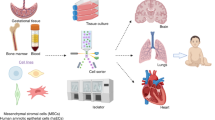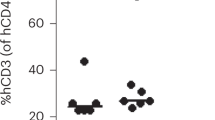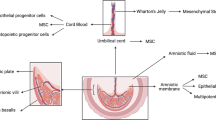Summary:
In utero transplantation (IUT) offers the potential to treat a large number of diseases by transplantation of healthy cells into a fetus with a birth defect. Prenatal diagnosis is feasible for many diseases prior to the full development of the fetal immune system offering the opportunity to introduce foreign cells and antigens into the developing fetus. At least 45 cases of IUT have been performed for a variety of diseases. IUT has successfully treated severe combined immunodeficiency and there are indications that it may be effective in treating some nonhematopoietic diseases. However, many diseases remain resistant to fetal therapy owing to the low levels of chimerism that can be achieved. Promising efforts to improve the levels of engraftment are focusing on optimizing the graft and developing donor-specific tolerance in the fetal recipient. Mounting evidence suggests that donor T cells can aid in achieving clinically significant levels of chimerism. The use of fetal donor cells may also offer some benefit. Animal experiments suggest that even low-level chimerism can lead to tolerance, which can be exploited by booster transplants in the neonate. Continued research appears likely to succeed in developing IUT into an effective form of therapy for a variety of diseases.
This is a preview of subscription content, access via your institution
Access options
Subscribe to this journal
Receive 12 print issues and online access
$259.00 per year
only $21.58 per issue
Buy this article
- Purchase on Springer Link
- Instant access to full article PDF
Prices may be subject to local taxes which are calculated during checkout
Similar content being viewed by others
References
Alfirevic Z, Sundberg K, Brigham S . Amniocentesis and chorionic villus sampling for prenatal diagnosis. Cochrane Database Systems Reviews 2003, CD003252.
Haynes BF . Phenotypic characterization and ontogeny of the human thymic microenviroment. Clin Res 1984; 32: 500–507.
Phillips JH, Hori T, Nagler A et al. Ontogeny of human natural killer (NK) cells: fetal NK cells mediate cytolytic function and express cytoplasmic CD3 epsilon, delta proteins. J Exp Med 1992; 175: 1055–1066.
Muench MO, Humeau L, Paek B et al. Differential effects of interleukin-3, interleukin-7, interleukin 15, and granulocyte-macrophage colony-stimulating factor in the generation of natural killer and B cells from primitive human fetal liver progenitors. Exp Hematol 2000; 28: 961–973.
Renda MC, Fecarotta E, Dieli F et al. Evidence of alloreactive T lymphocytes in fetal liver: implications for fetal hematopoietic stem cell transplantation. Bone Marrow Transplant 2000; 25: 135–141.
Lindton B, Markling L, Ringden O et al. Mixed lymphocyte culture of human fetal liver cells. Fetal Diagn Ther 2000; 15: 71–78.
Muench MO, Rae J, Bárcena A et al. Transplantation of a fetus with paternal Thy-1+CD34+ cells for chronic granulomatous disease. Bone Marrow Transplant 2001; 27: 355–364.
Muench MO, Pott Bartsch EM, Chen J-C et al. Ontogenic changes in CD95 expression on human leukocytes: prevalence of T-cells expressing activation markers and identification of CD95−CD45RO+ T-cells in the fetus. Dev Comp Immunol 2003; 27: 899–914.
Crombleholme TM, Langer JC, Harrison MR, Zanjani ED . Transplantation of fetal cells. Am J Obstet Gynecol 1991; 164: 218–230.
Touraine JL, Raudrant D, Golfier F et al. Reappraisal of in utero stem cell transplantation based on long-term results. Fetal Diagn Ther 2004; 19: 305–312.
Diukman R, Globus MS . In utero stem cell therapy. J Reprod Med 1992; 37: 515–520.
Wengler GS, Lanfranchi A, Frusca T et al. In-utero transplantation of parental CD34 haematopoietic progenitor cells in a patient with X-linked severe combined immunodeficiency (SCIDXI). Lancet 1996; 348: 1484–1487.
Flake AW, Roncarolo MG, Puck JM et al. Treatment of X-linked severe combined immunodeficiency by in utero transplantation of paternal bone marrow. N Engl J Med 1996; 335: 1806–1810.
Westgren M, Ringden O, Bartmann P et al. Prenatal T-cell reconstitution after in utero transplantation with fetal liver cells in a patient with X-linked severe combined immunodeficiency. Am J Obstet Gynecol 2002; 187: 475–482.
Pirovano S, Notarangelo LD, Malacarne F et al. Reconstitution of T-cell compartment after in utero stem cell transplantation: analysis of T-cell repertoire and thymic output. Haematologica 2004; 89: 450–461.
Gil J, Porta F, Bartolome J et al. Immune reconstitution after in utero bone marrow transplantation in a fetus with severe combined immunodeficiency with natural killer cells. Transplant Proc 1999; 31: 2581.
Bartolomé J, Porta F, Lafranchi A et al. B cell function after haploidentical in utero bone marrow transplantation in a patient with severe combined immunodeficiency. Bone Marrow Transplant 2002; 29: 625–628.
Porta F, Easton J, Caldiani C et al. Bone marrow transplantation in utero: report of 5 cases affected by severe combined immunodeficiency. Bone Marrow Transplant 2003; 31: S63.
Cowan MJ, Golbus M . In utero hematopoietic stem cell transplants for inherited diseases. Am J Pediatr Hematol Oncol 1994; 16: 35–42.
Flake AW . The fetus with a hematopoietic stem cell defect. In: Harrison MR, Evans MI, Adzick NS, Holzgreve W (eds). The Unborn Patient, The Art and Science of Fetal Therapy, Third edn, W.B. Saunders Company: Philadelphia, 2000, pp 591–603.
Westgren M, Ringden O, Eik-Nes S et al. Lack of evidence of permanent engraftment after in utero fetal stem cell transplantation in congenital hemoglobinopathies. Transplantation 1996; 61: 1176–1179.
Hayward A, Ambruso D, Battaglia F et al. Microchimerism and tolerance following intrauterine transplantation and transfusion for alpha-thalassemia-1. Fetal Diagn Ther 1998; 13: 8–14.
Slavin S, Naparstek E, Ziegler M, Lewin A . Clinical application of intrauterine bone marrow transplantation for treatment of genetic diseases – feasibility studies. Bone Marrow Transplant 1992; 9: 189–190.
Orlandi F, Giambona A, Messana F et al. Evidence of induced non-tolerance in HLA-identical twins with hemoglobinopathy after in utero fetal transplantation. Bone Marrow Transplant 1996; 18: 637–639.
Peschle C, Contu L, Melis G . In utero transplantation of purified stem cells from an HLA identical sibling into a beta-thalassemia embryo. In: Second International Meeting for In Utero Stem Cell Transplantationand Gene Therapy, 1997. Nottingham, England, 1997.
Sanna MA, Monni G, Ibba RM et al. In utero stem cell transplantation for beta-thalassemia: a case report. Bone Marrow Transplant 1999; 23: S109.
Monni G, Ibba RM, Zoppi MA, Floris M . In utero stem cell transplantation. Croat Med J 1998; 39: 220–223.
Shields LE, Lindton B, Andrews RG, Westgren M . Fetal hematopoietic stem cell transplantation: a challenge for the twenty-first century. J Hematother Stem Cell Res 2002; 11: 617–631.
Davies J . Clinicopathological conference. A case of haemolytic disease with congenital rubella demonstrated at the Royal Postgraduate Medical School. Br Med J 1967; 2: 819–822.
Thilaganathan B, Nicolaides KH, Morgan G . Intrauterine bone-marrow transplantation at 12 weeks' gestation. Lancet 1993; 342: 243.
Linch DC, Rodeck CH, Nicolaides K et al. Attempted bone-marrow transplantation in a 17-week fetus. Lancet 1986; 2: 1453.
Bambach BJ, Moser HW, Blakemore K et al. Engraftment following in utero bone marrow transplantation for globoid cell leukodystrophy. Bone Marrow Transplant 1997; 19: 399–402.
Leung W, Blakemore K, Jones RJ et al. A human-murine chimera model for in utero human hematopoietic stem cell transplantation. Biol Blood Marrow Transplant 1999; 5: 1–7.
Westgren L, Anneren G, Axelsson O et al. Donor chimerism across full allogenic barriers achieved by in utero transplantation of fetal mesenchymal stem cells in a case of osteogenesis imperfecta. Am J Obstet Gynecol 2003; 189: S215.
Touraine JL, Raudrant D, Royo C et al. In-utero transplantation of stem cells in bare lymphocyte syndrome. Lancet 1989; 1: 1382.
Haddad E, Landais P, Friedrich W et al. Long-term immune reconstitution and outcome after HLA-nonidentical T-cell-depleted bone marrow transplantation for severe combined immunodeficiency: a European retrospective study of 116 patients. Blood 1998; 91: 3646–3653.
Bethel CA, Murugesh D, Harrison MR et al. Selective erythroid replacement in murine beta-thalassemia using fetal hematopoietic stem cells. Proc Natl Acad Sci USA 1993; 90: 10120–10124.
Donahue J, Gilpin E, Young D, Carrier E . Postnatal cytokines and boosts improve chimerism and hematological parameters in beta-thalassemic mice transplanted in utero. Transplantation 2001; 71: 1491–1494.
Hayashi S, Abdulmalik O, Peranteau WH et al. Mixed chimerism following in utero hematopoietic stem cell transplantation in murine models of hemoglobinopathy. Exp Hematol 2003; 31: 176–184.
Persons DA, Allay ER, Sabatino DE et al. Functional requirements for phenotypic correction of murine beta-thalassemia: implications for human gene therapy. Blood 2001; 97: 3275–3282.
Rosen ED, Cornelissen I, Liang Z et al. In utero transplantation of wild-type fetal liver cells rescues factor X-deficient mice from fatal neonatal bleeding diatheses. J Thromb Haemostasis 2003; 1: 19–27.
Andreoletti M, LePercq J, Loux N et al. In utero allotransplantation of retrovirally transduced fetal hepatocytes in primates: feasibility and short-term follow-up. J Matern Fetal Med 1998; 7: 296–303.
Mahieu-Caputo D, Loux N, Simon L et al. In utero allotransplantation of fetal hepatocytes in primates. Fetal Diagn Ther 2004; 19: 92–99.
Almeida-Porada G, El Shabrawy D, Porada C, Zanjani ED . Differentiative potential of human metanephric mesenchymal cells. Exp Hematol 2002; 30: 1454–1462.
Fleischman RA, Mintz B . Development of adult bone marrow stem cells in H-2 compatible and noncompatible mouse fetuses. J Exp Med 1984; 159: 731–745.
Lansdorp PM . Developmental changes in the function of hematopoietic stem cells. Exp Hematol 1995; 23: 187–191.
Oppenheim SM, Muench MO, Gutiérrez-Adán A et al. Hematopoietic stem cell transplantation in utero produces sheep-goat chimeras. Blood Cells Mol Dis 2001; 27: 296–308.
Taylor PA, McElmurry RT, Lees CJ et al. Allogenic fetal liver cells have a distinct competitive engraftment advantage over adult bone marrow cells when infused into fetal as compared with adult severe combined immunodeficient recipients. Blood 2002; 99: 1870–1872.
Barker JE, Deveau S, Lessard M et al. In utero fetal liver cell transplantation without toxic irradiation alleviates lysosomal storage in mice with mucopolysaccharidosis type VII. Blood Cells Mol Dis 2001; 27: 861–873.
Golfier F, Bárcena A, Cruz J et al. Mid-trimester fetal livers are a rich source of CD34+/++ cells for transplantation. Bone Marrow Transplant 1999; 24: 451–461.
Golfier F, Bárcena A, Harrison MR, Muench MO . Fetal bone marrow as a source of stem cells for in utero or postnatal transplantation. Br J Haematol 2000; 109: 173–181.
Moretti L, Stramigioli S, Talevi N et al. Cryopreservation of human fetal liver: factors influencing granulocyte–macrophage colony (CFU-GM) survival after cryopreservation. Prog Clin Biol Res 1985; 193: 121–133.
Ek S, Ringden O, Markling L et al. Effects of cryopreservation on subsets of fetal liver cells. Bone Marrow Transplant 1993; 11: 395–398.
Jones DR, Anderson EM, Evans AA, Liu DT . Long-term storage of human fetal haematopoietic progenitor cells and their subsequent reconstitution. Implications for in utero transplantation. Bone Marrow Transplant 1995; 16: 297–301.
Mychaliska GB, Muench MO, Rice HE et al. The biology and ethics of banking fetal liver hematopoietic stem cells for in utero transplantation. J Pediatr Surg 1998; 33: 394–399.
Zhao J, Hao HN, Thomas RL, Lyman WD . An efficient method for the cryopreservation of fetal human liver hematopoeitic progenitor cells. Stem Cells 2001; 19: 212–218.
Rebel VI, Miller CL, Eaves CJ, Lansdorp PM . The repopulation potential of fetal liver hematopoietic stem cells in mice exceeds that of their liver adult bone marrow counterparts. Blood 1996; 87: 3500–3507.
Harrison DE, Zhong RK, Jordan CT et al. Relative to adult marrow, fetal liver repopulates nearly five times more effectively long-term than short-term. Exp Hematol 1997; 25: 293–297.
Guihard-Costa AM, Larroche JC, Droulle P, Narcy F . Fetal Biometry. Growth charts for practical use in fetopathology and antenatal ultrasonography. Introduction. Fetal Diagn Ther 1995; 10: 215–278.
Shields LE, Gaur LK, Gough M et al. In utero hematopoietic stem cell transplantation in nonhuman primates: the role of T cells. Stem Cells 2003; 21: 304–314.
Crombleholme TM, Harrison MR, Zanjani ED . In utero transplantation of hematopoietic stem cells in sheep: the role of T cells in engraftment and graft-versus-host disease. J Pediatr Surg 1990; 25: 885–892.
Chou SH, Chawla A, Lee TH et al. Increased engraftment and GVHD after in utero transplantation of MHC-mismatched bone marrow cells and CD80 low, CD86(−) dendritic cells in a fetal mouse model. Transplantation 2001; 72: 1768–1776.
Bhattacharyya S, Chawla A, Smith K et al. Multilineage engraftment with minimal graft-versus-host disease following in utero transplantation of S-59 psoralen/ultraviolet A light-treated, sensitized T Cells and adult T cell-depleted bone marrow in fetal mice. J Immunol 2002; 169: 6133–6140.
Carrier E, Gilpin E, Lee TH et al. Microchimerism does not induce tolerance after in utero transplantation and may lead to the development of alloreactivity. J Lab Clin Med 2000; 136: 224–235.
Donahue J, Gilpin E, Lee TH et al. Microchimerism does not induce tolerance and sustains immunity after in utero transplantation. Transplantation 2001; 71: 359–368.
Chen JC, Chang ML, Lee H, Muench MO . Haploidentical donor T cells fail to facilitate engraftment but lessen the immune response of host T cells in murine fetal transplantation. Br J Haematol 2004; 126: 377–384.
Chen J-C, Chang M-L, Lee H, Muench MO . Prevention of graft rejection by donor type II CD8+ T-cells (Tc2 cells) is not sufficient to improve engraftment in fetal transplantation. Fetal Diagn Ther 2005; 20: 35–43.
Carrier E, Lee TH, Busch MP, Cowan MJ . Induction of tolerance in nondefective mice after in utero transplantation of major histocompatibility complex-mismatched fetal hematopoietic stem cells. Blood 1995; 86: 4681–4690.
Hayashi S, Peranteau WH, Shaaban AF, Flake AW . Complete allogeneic hematopoietic chimerism achieved by a combined strategy of in utero hematopoietic stem cell transplantation and postnatal donor lymphocyte infusion. Blood 2002; 100: 804–812.
Mathes DW, Yamada K, Randolph MA et al. In utero induction of transplantation tolerance. Transplant Proc 2001; 33: 98–100.
Sharabi Y, Abraham VS, Sykes M, Sachs DH . Mixed allogeneic chimeras prepared by a non-myeloablative regimen: requirement for chimerism to maintain tolerance. Bone Marrow Transplant 1992; 9: 191–197.
Acknowledgements
I am indebted to many colleagues who have shared their hard efforts and enthusiasm with me in the pursuit of developing the practice of fetal transplantation. Special thanks go to Drs Alicia Bárcena, Jeng-Chang Chen, François Golfier, Michael R Harrison and Yuet-Wai Kan. This work was supported in part by NIH Grant DK59301.
Author information
Authors and Affiliations
Corresponding author
Rights and permissions
About this article
Cite this article
Muench, M. In utero transplantation: baby steps towards an effective therapy. Bone Marrow Transplant 35, 537–547 (2005). https://doi.org/10.1038/sj.bmt.1704811
Published:
Issue Date:
DOI: https://doi.org/10.1038/sj.bmt.1704811
Keywords
This article is cited by
-
Transplanting FVIII/ET3-secreting cells in fetal sheep increases FVIII levels long-term without inducing immunity or toxicity
Nature Communications (2023)
-
Application potential of bone marrow mesenchymal stem cell (BMSCs) based tissue-engineering for spinal cord defect repair in rat fetuses with spina bifida aperta
Journal of Materials Science: Materials in Medicine (2016)
-
Feasibility and potential of in utero foetal membrane-derived cell transplantation
Cell and Tissue Banking (2014)
-
Immunoresponse against the transgene limits hematopoietic engraftment of mice transplanted in utero with virally transduced fetal liver
Gene Therapy (2011)
-
In utero transplantation: baby steps towards an effective therapy
Bone Marrow Transplantation (2005)



